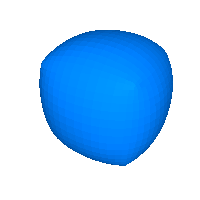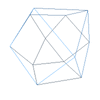

This is is a variant of Chaikin's corner-cutting algorithm. It is similar in spirit to a number of subdivision schemes for producing smooth surfaces from an original set of control vertices, including the Doo-Sabin algorithm and the Catmull-Clark(?) algorithm, which pick distances and weights so as to produce B-spline surfaces, and the Loop scheme, which is the grandfather of much of today's work on subdivision surfaces in graphics.
It's an interesting variant because it's singular in some sense: normally corner cutting algorithms cut off a little section 'w' at either end of each edge in the original model (w = 1/4 in the original chaikin algorithm), leaving some of the original edge. This variant results in the original edge vanishing.
Notes














So the result seems to be a pin cushion-like surface with G1 discontinuities corresponding to the original vertices.
Gratuitous animated gifs:

